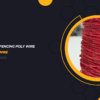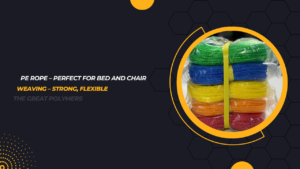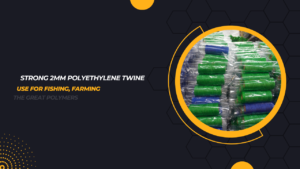When it comes to versatile and reliable cordage, few materials can match the performance of PE twine and rope. Whether you’re reinforcing a construction site, hauling in the day’s catch on a fishing boat, or securing gear on a marine vessel, PE (Polyethylene) rope offers durability, strength, and resilience in some of the harshest environments. In this comprehensive guide, we’ll delve deep into the benefits, uses, and technical specs of PE twine and rope in 1.5 mm, 1.7 mm, and 2 mm diameters, with a special spotlight on THE GREAT POLYMERS – India, a premier manufacturer known for quality and reliability.
What is PE Twine and Rope?
PE (Polyethylene) twine and rope is made from high-density or low-density polyethylene fibers. These synthetic polymers are widely used due to their high tensile strength, excellent resistance to abrasion, and superior performance in wet and salty conditions.
PE ropes are lightweight, floats on water, and have low stretch, making them ideal for both industrial and commercial applications.
High UV resistance – Withstands long sun exposure without degradation
Chemical resistance – Unaffected by most acids and alkalis
Waterproof and buoyant – Ideal for marine environments
Flexible yet strong – Easy to handle, yet capable of heavy-duty performance
Affordable and long-lasting – Offers excellent value for cost
Popular Sizes: 1.5 mm, 1.7 mm, and 2 mm – What’s the Difference?
1.5 mm PE Rope
- Lightweight and flexible
- Ideal for light-duty packaging, tying nets, or tagging
- Great for aquaculture cages and garden applications
1.7 mm PE Rope
- Slightly thicker and stronger
- Common in medium-load fishing tasks and utility tying
- Often used in sports nets and construction marking
2 mm PE Rope
- Designed for heavier-duty tasks
- Excellent for general marine use, heavy netting, and scaffolding lines
- Suitable for mooring small boats and tying tarpaulins
Applications of PE Twine and Rope
Construction Industry
PE ropes are essential on construction sites for boundary marking, scaffolding tie-downs, and load securing. Their non-conductive nature makes them safe to use around electrical systems.
Fishing Sector
Fishermen rely on PE rope for:
- Net weaving and repairs
- Float lines and anchor ties
- Buoy setups and crab/lobster traps
Marine and Nautical Uses
Onboard vessels, PE rope’s buoyancy is a massive advantage. It’s used for:
- Dock lines and fenders
- Lifebuoy attachments
- Tying light gear on deck
Agriculture and Gardening
Farmers and gardeners use PE twine for:
- Vineyard trellising
- Crop support and bundling
- Boundary fences and shade nets
Why Sourcing Quality Matters: The Role of THE GREAT POLYMERS/INDIA
THE GREAT POLYMERS, based in India, is renowned for delivering high-quality PE ropes and twine that meet both domestic and international standards. Here’s why they’re a top choice:
- ISO-certified manufacturing processes
- Customizable sizes and lengths
- Bulk supply capability for large-scale projects
- Consistent product quality and prompt delivery
- Eco-conscious production with recyclable materials
Choosing a reliable supplier like THE GREAT POLYMERS ensures that you’re not just buying rope—you’re investing in performance and peace of mind.
| Property | Value |
|---|---|
| Material | 100% Virgin Polyethylene |
| Sizes Available | 1.5 mm, 1.7 mm, 2 mm (custom sizes available) |
| Construction | 3-strand twisted or braided |
| UV Resistance | High |
| Density | ~0.91 g/cm³ (Floats on water) |
| Color Options | Blue, Green, Yellow, Red, Custom |
| Coil Lengths | 50 m to 500 m (Customizable) |
PE Rope vs. Other Materials
| Feature | PE Rope | Nylon Rope | Cotton Rope |
|---|---|---|---|
| Water Resistance | Excellent | Good | Poor |
| UV Resistance | High | Moderate | Low |
| Strength-to-weight | High | High | Low |
| Cost | Low | Medium to High | Low |
| Durability | Excellent | Excellent | Moderate |
As seen above, PE ropes outperform natural fibers in virtually every category, especially in wet, outdoor, or industrial environments.
Customization Options Available
THE GREAT POLYMERS offers multiple customization options to meet specific project requirements:
- Color coding for identification
- Pre-cut lengths or bulk coils
- UV-stabilized colors for outdoor longevity
- Private labeling and OEM packaging for resellers and distributors
These options make them the preferred supplier for exporters, OEM manufacturers, and infrastructure developers.
Tips for Selecting the Right PE Rope
- Match diameter with load – Thicker ropes for heavier loads
- Consider the environment – Use UV-stabilized ropes for outdoor use
- Check for certification – Always go for ropes tested for durability
- Buy from trusted sources – Ensure consistency and performance
Caring for Your PE Rope
Even though PE ropes are tough, a little care ensures even longer use:
- Store in a cool, dry place away from direct sun when not in use
- Avoid contact with sharp edges to prevent fraying
- Wash off salt or chemicals after marine or industrial use
- Inspect regularly for signs of wear or UV damage
Conclusion: PE Rope – The All-Around Solution for Tough Jobs
Whether you’re lashing scaffolding in the middle of a construction project, hauling in fishing nets offshore, or docking a boat at sea, PE twine and rope in 1.5 mm, 1.7 mm, and 2 mm sizes deliver unmatched performance. Their durability, water resistance, UV protection, and affordability make them an indispensable tool in countless industries.
And when you choose a reputable supplier like THE GREAT POLYMERS in India, you get the assurance of quality, consistency, and long-term value. For both large-scale projects and everyday utility, PE rope is the smart choice.











Leave a reply